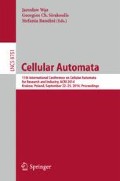Abstract
We consider a simple TASEP (Totally Asymmetric Simple Exclusion Process) network model with an aggregation point and a branching point. Generally speaking, the aggregation point behaves as a bottleneck and the branching point enables particles to encourage their velocity. However, the correlation among multiple junctions in TASEP network is not known so much. In order to investigate the correlation, we consider a simple TASEP network which including two junctions and discuss the network with an aggregation point and a branching point. From our theoretical analysis and numerical results, it is shown that aggregations become bottlenecks in TASEP networks and that branches enable flow of particles to be larger in many cases.
Access this chapter
Tax calculation will be finalised at checkout
Purchases are for personal use only
Preview
Unable to display preview. Download preview PDF.
References
Conway, R.W., Maxwell, W.L., Miller, L.W.: Theory of Scheduling. Dover Publications, Inc., Minesota
Ghrist, R.: Configuration Spaces and Braid Groups on Graphs in Robotics. In: Braids, Links, and Mapping Class Groups: the Proceedings of Joan Birman’s 70th Birthday. AMS/IP Studies in Mathematics, vol. 24, pp. 29–40 (2001)
Rajewsky, N., Santen, L., Schadschneider, A., Schreckenberg, M.: The Asymmetric Exclusion Process: Comparison of Update Procedures. Journal of Physics 92(1/2), 151–194 (1998)
Huang, D.-W.: Ramp-induced transitions in traffic dynamics. Physical Review E 73, 016123 (2006)
Huang, D.-W.: Analytical results of asymmetric exclusion processes with ramps. Physical Review E 72, 016102 (2005)
MacDonald, C.T., Gibbs, J.H.: Kinetics of Biopolymerization on Nucleic Acid Templates. Biopolymers 6, 1–25 (1968)
Spitzer, F.: Interaction of Markov Process. Advances in Mathematics 5, 246–290 (1970)
Pronina, E., Kolomeisky, A.B.: Theoretical investigation of totally asymmetric exclusion processes with on lattices with junctions. J. Stat. Mech., P07010 (2005)
Wang, X., Jiang, R., Hu, M.-B., Nishinari, K., Wu, Q.-S.: Totally Asymmetric Exclusion Process on Lattices with a Branching Point. International Journal of Modern Physics C 20(12), 1999–2012 (2009)
Derrida, B., Evans, M.R., Hakim, V., Pasquier, V.: Exact solution of a ID asymmetric exclusion model using a matrix formulation. J. Phys. A: Math. Gen. 26, 1493–1517 (1993)
Wang, X., Jiang, R., Nishinari, K., Hu, M.-B., Wu, Q.-S.: Asymmetric Exclusion Processes on Lattices with a Junction: The Effect of Unequal Injection Rates. International Journal of Modern Physics C 20(6), 967–978 (2009)
Parmeggiani, A., Franosch, T., Frey, E.: The Totally Asymmetric Simple Exclusion Process with Langmuir Kinetics. Physical Review E 70, 046101 (2004)
Kolomeisky, A.B., Schütz, G.M., Kolomeisky, E.B., Straley, J.P.: Phase diagram of one-dimensional driven lattice gases with open boundaries. J. Phys. A: Math. Gen. 31, 6911–6919 (1998)
Embley, B., Parmeggiani, A., Kern, N.: Understanding Totally Asymmetric Simple-exclusion-process Transport on Networks: Generic Analysis via Effective Rates and Explicit Vertices. Physical Review E 80, 041128 (2009)
Raguin, A., Parmeggiani, A., Kern, N.: Role of Network Junctions for the Totally Asymmetric Simple Exclusion Process. Physical Review E 88, 042104 (2013)
Lebacque, J.-P.: First-order Macroscopic Traffic Flow Models: Intersection Modeling, Network Modeling. In: Mahmassani, H.S. (ed.) Transportation and Traffic Theory Flow, Dynamics, and Human Interaction, Proceeding of 16th International Symposium on Transportation and Traffic Theory, pp. 365–386 (2005)
Author information
Authors and Affiliations
Editor information
Editors and Affiliations
Rights and permissions
Copyright information
© 2014 Springer International Publishing Switzerland
About this paper
Cite this paper
Tannai, T., Nishinari, K. (2014). Interactions between Multiple Junctions. In: Wąs, J., Sirakoulis, G.C., Bandini, S. (eds) Cellular Automata. ACRI 2014. Lecture Notes in Computer Science, vol 8751. Springer, Cham. https://doi.org/10.1007/978-3-319-11520-7_67
Download citation
DOI: https://doi.org/10.1007/978-3-319-11520-7_67
Publisher Name: Springer, Cham
Print ISBN: 978-3-319-11519-1
Online ISBN: 978-3-319-11520-7
eBook Packages: Computer ScienceComputer Science (R0)

